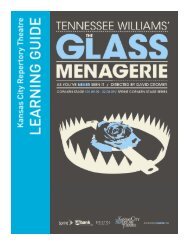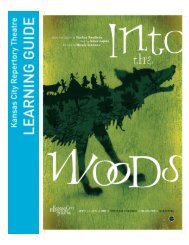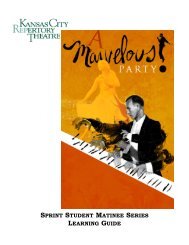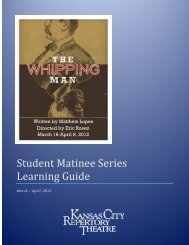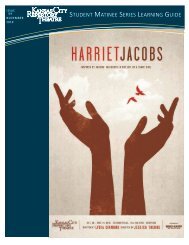A Christmas Carol - The Kansas City Repertory Theatre
A Christmas Carol - The Kansas City Repertory Theatre
A Christmas Carol - The Kansas City Repertory Theatre
Create successful ePaper yourself
Turn your PDF publications into a flip-book with our unique Google optimized e-Paper software.
LONDON’S YOUNG POOR<br />
Many children in London were poor, even homeless. Most spent their days earning money for their<br />
families, instead of going to school, as does Martha Cratchit in A <strong>Christmas</strong> <strong>Carol</strong>. Children had to share<br />
beds: four people in the same bed. <strong>The</strong>y often had to take turns to sleep in the beds or on mattresses.<br />
Many families owned tin baths which they filled with water, usually once a week. <strong>The</strong> family members<br />
all used the same water, one after the other. Houses were warmed by coal fires, which made the area<br />
smelly and smoky in the winter.<br />
Because of the poor living conditions and<br />
lack of proper nourishment, there were<br />
thousands of children, like Tiny Tim, who<br />
were sickly or had ailments and died<br />
young. Many people were too poor to<br />
buy medicine or go to doctors and there<br />
were no vaccines to prevent diseases like<br />
measles, mumps, rubella, diphtheria,<br />
whooping cough, and polio. As a result, a<br />
large percentage of children died from<br />
these illnesses. In 1839, nearly half of the<br />
funerals were for children under the age<br />
of ten.<br />
Child laborers in London, circa 1900.<br />
Since many parents did not allow their children to work in the new textile factories, factory owners<br />
bought children from orphanages and workhouses, making them virtual slaves, housed in crowded and<br />
filthy buildings. <strong>The</strong> children, who usually began work at age ten to thirteen, were forced to sign<br />
contracts indebting them until age twenty‐one. By the beginning of the nineteenth century these<br />
“pauper apprentices” made up about a third of the cotton industry workers.<br />
In needlework factories in London, teenage girls worked twelve to eighteen hour days, six days a week.<br />
In the coal mines, boys and girls as young as five were put to work in the shafts because of their small<br />
bodies. Stripped of most of their clothes, chained to coal carts, they performed dangerous and grueling<br />
work underneath the earth.<br />
Many children grew up without education and virtually no chance to escape the cycle of poverty.<br />
Dickens felt that this cycle of poverty could be broken by education and became interested in the<br />
“Ragged Schools” in London. Ragged Schools were for poor children in the cities who could not afford<br />
the tuition of the more common private schools. <strong>The</strong>se schools were not well attended, however,<br />
because many of the children had to work to support their families.<br />
A <strong>Christmas</strong> <strong>Carol</strong>: Learning Guide Page 17



